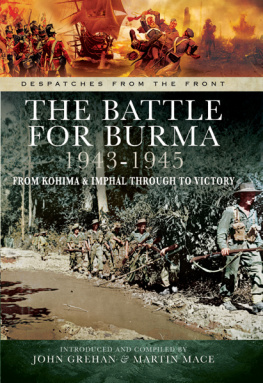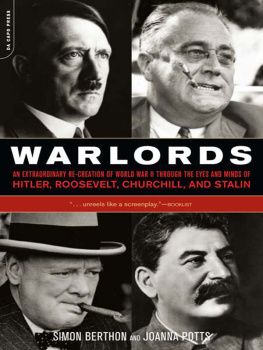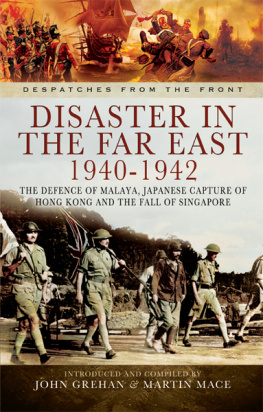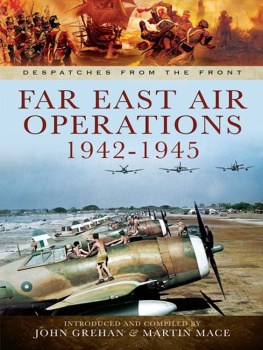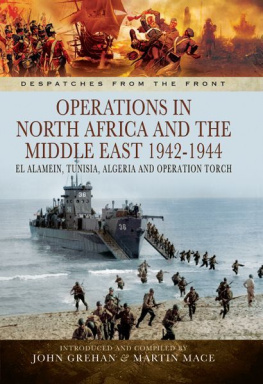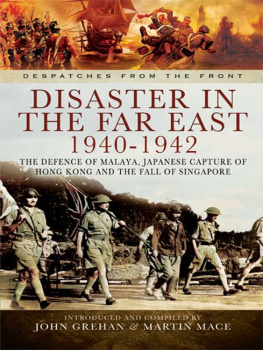First published in Great Britain in 2015 by
PEN & SWORD MILITARY
An imprint of
Pen & Sword Books Ltd
47 Church Street
Barnsley
South Yorkshire
S70 2AS
Copyright John Grehan and Martin Mace, 2015
ISBN: 978-1-78346-210-0
EPUB ISBN: 978-1-47386-359-0
PRC ISBN: 978-1-47386-358-3
The right of John Grehan and Martin Mace to be identified as the authors of this work has been asserted by them in accordance with the Copyright, Designs and Patents Act 1988.
A CIP catalogue record for this book is available from the British Library.
All rights reserved. No part of this book may be reproduced or transmitted in any form or by any means, electronic or mechanical including photocopying, recording or by any information storage and retrieval system, without permission from the Publisher in writing.
Typeset by Concept, Huddersfield, West Yorkshire HD4 5JL.
Printed and bound in England by CPI Group (UK) Ltd, Croydon CR0 4YY.
Pen & Sword Books Ltd incorporates the imprints of Pen & Sword Archaeology, Atlas, Aviation, Battleground, Discovery, Family History, History, Maritime, Military, Naval, Politics, Railways, Select, Social History, Transport, True Crime, and Claymore Press, Frontline Books, Leo Cooper, Praetorian Press, Remember When, Seaforth Publishing and Wharncliffe.
For a complete list of Pen & Sword titles please contact
PEN & SWORD BOOKS LIMITED
47 Church Street, Barnsley, South Yorkshire, S70 2AS, England
E-mail:
Website: www.pen-and-sword.co.uk
Contents
Introduction
The sudden, though hardly unexpected, attack upon US and British territory on 7 and 8 December 1941, almost immediately placed Burma on the front line. With Burma sharing a frontier with India the decision was quickly taken to place the defence of Burma under responsibility of the Commander-in-Chief in India, General Sir Archibald P. Wavell. This came into effect on 15 December.
When Wavell went to inspect his new command he found its defences to be wholly inadequate. This, he explains in his despatch, was entirely understandable as Burma was bordered by two friendly, neutral nations, Thailand and French Indo-China, both of which professed their intention to defend themselves against Japanese aggression. Except as a subsidiary air base, Wavell concedes, Burma hardly entered into the strategic plans of the Far East Command, which was concerned with the defence of Hong Kong and Malaya/Singapore.
The entire situation changed when Vichy France handed over control of Indo-China to Japan in 1940 and then, on 21 December 1941, Thailand signed a treaty of friendship with Japan after it had been invaded.
At the time Wavell took over there were just two British infantry battalions, two Indian infantry brigades, and eight battalions of Burma Rifles to defend a country with a land mass almost three times that of the United Kingdom. In terms of air defence, Burma possessed one squadron of Blenheims, and one of Brewster Buffaloes plus one squadron of Hurricanes which arrived in January 1941, becoming operational on the 26th of that month.
The air defences of Burma, especially of the vital port of Rangoon, would have been overwhelmed at once but for the presence in Burma of the American Volunteer Group (AVG) an air force manned by American pilots for the defence of China which was equipped with Curtiss P-40 fighters.
The Japanese attack on Burma began on 19 January 1942, with easy initial gains through, according to Wavell, bad handling by local Commanders, lack of training and in some instances lack of fighting spirit on the part of our troops. Wavell was informed that Rangoon was the likely objective of the enemy.
Wavell quickly moved every unit he could into the area to try and hold the Japanese advance. He had already despatched the 17th Division from India and he diverted 7 Armoured Brigade which was on its way from the Middle East to Malaya. By this time the troops in Malaya had been driven into Singapore Island and the Armoured Brigade was obviously of no use there. A regiment of field artillery was also moved into Burma as well as 46 and 63 Indian Infantry Brigades to strengthen 17 Indian Division.
Wavells despatch outlining operations up to 20 May 1942 includes a report from Lieutenant General T.J. Hutton who assumed command in Burma on 27 December 1941. When the Japanese attack began three weeks later 16 Indian Brigade stood in the path of the enemy but, fearing it might be overwhelmed and destroyed by the Japanese, was told to undertake a fighting withdrawal.
The crucial engagement took place at the only bridge over the River Sittang on the road to Rangoon. Brigadier John Smyth, who had been awarded with the Victoria Cross in the First World War, was in charge of 17 Division. Smyth had been told to blow the bridge but around half of his men were still on the far bank of the river when the Japanese arrived. Smyth took the bold decision to blow the bridge to stop the Japanese rushing down the road to Rangoon.
Smyth delayed the Japanese advance and many of the stranded soldiers were able to subsequently swim across the river as the Japanese had moved along the river to find an alternative crossing point. The division was reduced to around 40 per cent of its strength, having lost most of its equipment. Smyth was dismissed and was never given another command.
The Japanese were soon across the Sittang and bore down on Rangoon. A stand was made at Pegu which delayed the Japanese until 7 March but already the evacuation of Rangoon was being considered. That decision was Wavells alone.
Rangoon was given up as a lost cause by the Chiefs of Staff who chose instead not to send 7 Australian Division to Burma as previously arranged and at the last moment the East African Brigade was diverted elsewhere. That, as Hutton wrote, sealed the fate of the Burmese capital.
Already the now well-known characteristics of the Japanese had begun to be seen, as Hutton observed:
Perhaps the most important characteristic of the Japanese soldier is his ability to live almost entirely on the country and to dispense with the enormous administrative organisation in rear of the fighting troops that is required by most armies.
He achieves this by being tough. He can live for five days on the rice he actually carries and he has been taught that he must reduce his expenditure of ammunition to that which he can carry. He uses any means of transport available porters, civilians, bullock carts, boats, captured M.T., etc., but has little in the unit. His troops do not expect to be carried everywhere in M.T. The other main point is his insistence on the offensive spirit and the tactics of envelopment. Quite small forces will work round the rear of a much larger force and may succeed in defeating it entirely by bluff They do not hesitate to fight in plain clothes or enemy uniform if it suits their purpose and, although they may deny any deliberate policy of committing atrocities, both officers and men often kill or maim prisoners or wounded after capture in a most brutal and coldblooded manner. They neglect enemy wounded completely even more than they do their own.
There is no doubt that the tough, ruthless Japanese were too determined to be stopped. In time, the British and their Allies would learn how to defeat the Japanese but, in those early months of the war in the Far East the Japanese very quickly gained the upper hand.
Hutton was superseded by General Harold Alexander on 5 March 1941. On arriving in the region he was given his instructions by Wavell, which were that:
The retention of Rangoon was a matter of vital importance to our position in the Far East and every effort must be made to hold it. If, however, that was not possible the force must not be allowed to be cut off and destroyed but must be withdrawn from the Rangoon area for the defence of Upper Burma. This must be held as long as possible in order to safeguard the oil fields at Yenangyaung, keep contact with the Chinese and protect the construction of the road from Assam to Burma.
Next page



